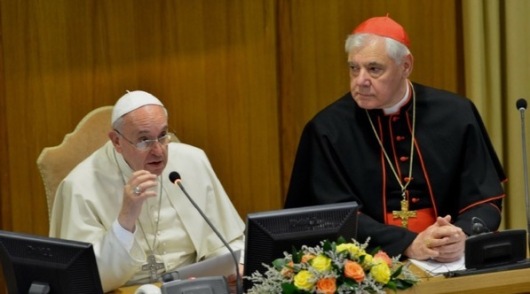
685 words, 4 min read
It is interesting to see the approach that Cardinal Gerhard Ludwig Müller has taken to responding to an ostensible call from “many bishops, priests, religious and lay people of the Catholic Church” to “make a public testimony about the truth of revelation”, which he constructs by referencing 33 of the Catechism’s 2865 paragraphs.
Sadly, those 33 paragraphs do not include the one that would have sufficed: §85, which goes like this and two thirds of which come from one of Vatican II’s four dogmatic constitutions – Dei Verbum:
““The task of giving an authentic interpretation of the Word of God, whether in its written form or in the form of Tradition, has been entrusted to the living teaching office of the Church alone. Its authority in this matter is exercised in the name of Jesus Christ.” (Dei Verbum, §10) This means that the task of interpretation has been entrusted to the bishops in communion with the successor of Peter, the Bishop of Rome.”
Also curious is the total lack of mention of the pope, the “successor of Peter, the Bishop of Rome” in Cardinal Müller’s attempt to dispel confusion and shed light on the “many bishops, priests, religious and lay people of the Catholic Church” who are currently at a loss with regard to the “truth of revelation”, especially since he is rather central (to put it mildly) to the “shepherds’ very own task” that Cardinal Müller self-attributes in his statement. Yet again the answer is in the Catechism that Cardinal Müller presents – quoting St. John Paul II’s Fidei Depositum – as the “safe standard for the doctrine of the faith” in the opening paragraph of his declaration. There, at §883, and quoting from another of Vatican II’s dogmatic constitutions, we read:
““The college or body of bishops has no authority unless united with the Roman Pontiff, Peter’s successor, as its head.” As such, this college has “supreme and full authority over the universal Church; but this power cannot be exercised without the agreement of the Roman Pontiff.” (Lumen Gentium, §22)”
Besides such paradigmatic confusion, Cardinal Müller also seems to be exercising some, shall we say, poetic license. Just to give an example, he presents “[f]or he who dies in mortal sin without repentance will be forever separated from God” as the summary of §1033, which reads:
“We cannot be united with God unless we freely choose to love him. But we cannot love God if we sin gravely against him, against our neighbor or against ourselves: “He who does not love remains in death. Anyone who hates his brother is a murderer, and you know that no murderer has eternal life abiding in him.” (1 Jn 3:14-15) Our Lord warns us that we shall be separated from him if we fail to meet the serious needs of the poor and the little ones who are his brethren. (Cf. Mt 25:31-46.) To die in mortal sin without repenting and accepting God’s merciful love means remaining separated from him for ever by our own free choice. This state of definitive self-exclusion from communion with God and the blessed is called “hell.””
I’m afraid the Catechism (and the magisterium of at least the last three popes) is a shade more nuanced. Instead of Cardinal Müller’s “[f]or he who dies in mortal sin without repentance will be forever separated from God” we have “[t]o die in mortal sin without repenting and accepting God’s merciful love means remaining separated from him for ever by our own free choice” (emphasis mine). Not the same and a bit confusing, if you ask me … or even better, if you ask the Pope, or read and put into practice the Gospel, or read the whole Catechism, instead of Reader’s Digest versions of 33 of its 2865 paragraphs.
Finally, the entire missive ends on another confusion, which is its author’s title, given as “Prefect of the Congregation for the Doctrine of the Faith 2012-2017” and which instead ought to be “Prefect emeritus of the Congregation for the Doctrine of the Faith”, with all the implications of authority that this difference entails.












